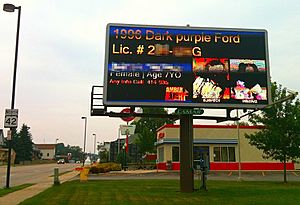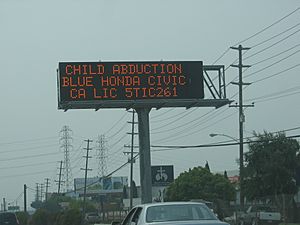Amber alert facts for kids
An AMBER Alert is a special message sent out to the public to help find children who have been taken. It's like a big "all points bulletin" asking everyone to keep an eye out. This system first started in the United States.
The name AMBER is actually a special kind of acronym. It stands for America's Missing: Broadcast Emergency Response. This name was chosen to remember Amber Rene Hagerman, a nine-year-old girl who was taken and sadly found dead in 1996. In some places, these alerts had different names, like "Levi's Call" in Georgia or "Rachael Alert" in Utah.
In the United States, AMBER Alerts are sent out in many ways. You might hear them on regular radio stations, Internet radio, or see them on television stations and cable TV. They also go out as text messages to phones, on electronic signs on highways, and even on digital billboards.
AMBER Alert also works with big companies like Google, Bing, and Facebook. This means if you search for information about a missing child in a certain area, you might see an AMBER Alert pop up. You can even sign up to get these alerts as free text messages on your phone. In some states, the screens at lottery ticket machines also show the alerts.
Police departments decide when to send out an AMBER Alert. They usually share information like the child's name and what they look like, a description of the person who took them, and details about any car involved, including the license plate number.
Contents
How AMBER Alerts Work

These alerts use the Emergency Alert System, which is also used for weather warnings or other big emergencies. In Canada, they use a similar system called Alert Ready. The alerts usually describe the child and the person who might have taken them.
To make sure alerts are only sent when truly needed, there are strict rules. Each state or province has its own rules, but the U.S. Department of Justice gives these guidelines:
- Police must confirm that a child has been taken.
- The child must be in serious danger.
- There must be enough information about the child, the person who took them, or their vehicle to help find them.
- The child must be under 17 years old.
Sometimes, an AMBER Alert is sent even if a child is taken by a parent during a family disagreement, not just by a stranger. Police also share information about these cases with the Federal Bureau of Investigation (FBI) to help with the search.
If police think a child might be taken across the border to Canada or Mexico, border officials are told to look for them.
When an Alert Isn't Issued
If a case doesn't meet the strict rules for an AMBER Alert, other programs can still help. The Child Abduction Response Teams (CART) program helps local police agencies. These teams can help find any missing child, even if they ran away and are in danger.
About Amber Hagerman
Quick facts for kids
Amber Hagerman
|
|
|---|---|

Amber Hagerman in December 1995, shortly before she was taken in January 1996
|
|
| Born |
Amber Rene Hagerman
November 25, 1986 Arlington, Texas, U.S.
|
| Disappeared | January 13, 1996 |
| Died | January 15, 1996 (aged 9) Arlington, Texas, U.S.
|
| Cause of death | Died tragically |
| Body discovered | January 17, 1996 |
| Parent(s) | Donna Norris, Richard Hagerman |
Amber Rene Hagerman was born on November 25, 1986. She was nine years old when she was taken while riding her bike in Arlington, Texas, on January 13, 1996. Her younger brother, Ricky, had gone home, and when he came back with their grandfather, only Amber's bicycle was there. A neighbor who saw what happened called 911.
Amber's mother, Donna Whitson, quickly called the news and the FBI. Her family and neighbors started searching for her. Sadly, four days later, Amber's body was found by a man walking his dog. Her case is still unsolved today.
Around the World
United States
In 2000, the United States House of Representatives encouraged communities to start AMBER Plans. By 2005, all fifty states in the U.S. had AMBER Alert programs. Since 2013, AMBER Alerts are automatically sent to most cell phones through the Wireless Emergency Alerts (WEA) program.
Canada
Canada started its system in December 2002 in Alberta. Other provinces soon followed. By 2005, the program was used across the country.
In Canada, AMBER Alerts can also interrupt TV and radio shows to share information. Since 2018, they also go to supported mobile phones. These phone alerts make a loud sound, even if your phone is on silent. This has caused some debate, but it's meant to make sure people hear about serious emergencies.
In British Columbia, the transportation network, TransLink, shows AMBER Alerts on bus signs and at transit stations.
In Quebec, the program started in 2003. The name was changed to Alerte Médiatique But Enfant Recherché, which means "Media Alert for Child Recovery." They have four main rules for issuing an alert, similar to the U.S.
In Ontario, AMBER Alerts are also shown on screens at 9,000 lottery terminals. After a case involving Victoria Stafford, the rules for issuing an alert were changed. Now, police only need to believe a child has been taken and is in danger, making it easier to send an alert quickly.
Other Countries
- Mexico joined the AMBER Alert efforts in 2011.
- Australia started its version in Queensland in 2005.
- Europe has the AMBER Alert Europe foundation, which works to protect missing children across different countries. They help police share information and improve how missing children cases are handled.
- France launched its system, called Alerte-Enlèvement, in 2006.
- Netherlands started AMBER Alert Netherlands in 2008. The first Dutch alert helped find a 4-year-old boy very quickly.
- United Kingdom launched its nationwide Child Rescue Alert in 2010, based on the AMBER Alert system.
- Ireland introduced the Child Rescue Ireland (CRI) Alert in 2012.
- Slovakia has "AMBER Alert Slovakia" since 2015.
- Ukraine launched AMBER Alert in 2021.
- China started its platform for missing children information in 2016, working with Alibaba Group.
- Malaysia implemented the Nurin Alert in 2007, named after a missing girl.
- Ecuador introduced its EMILIA Alert in 2018.
- Russia has MegaFon.Poisk, an alert system developed in 2019.
How Successful Are They?
AMBER Alerts are designed to tell the public quickly when a child is in danger. This helps more people become "eyes and ears" for the police. As of August 2013, the National Center for Missing & Exploited Children estimates that 657 children have been found safely because of the AMBER Alert program.
A study in 2004 looked at 233 AMBER Alerts. It found that about half of them were for children taken by a parent, often during a family custody disagreement. Some alerts were for children who were lost or had run away, not actually abducted. About 30% of the alerts were for children taken by strangers or adults who were not their legal guardians.
In 2014, 186 AMBER Alerts were issued in the U.S., involving 239 children. Sixty of these children were taken by strangers or people other than their legal guardians.
Traffic Impact
AMBER Alerts are often shown on electronic signs on highways. However, these alerts are used carefully because they can distract drivers and cause traffic congestion.
Many states have rules about when to use highway signs for alerts. For example, in Los Angeles, an alert in 2002 caused a lot of traffic. Because of this, the California Highway Patrol decided not to show alerts during rush hour. They always put traffic safety messages first.
Influence and Legacy
The United States Postal Service released a postage stamp about AMBER Alerts in 2006. The stamp shows a mother and child reunited, with the words "AMBER ALERT saves missing children."
In 2006, a TV movie called Amber's Story was made about Amber Hagerman. A comic book, Amber Hagerman Deserves Justice: A Night Owl Story, was also published in 2009. It tells Amber's story and talks about how her death has affected families.
See also
 In Spanish: Alerta AMBER para niños
In Spanish: Alerta AMBER para niños





